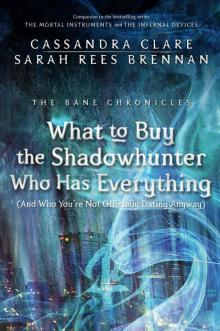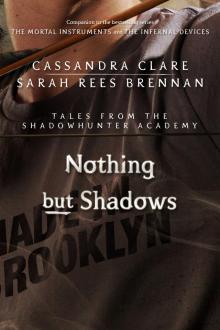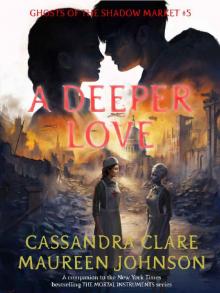- Home
- Cassandra Clare
Shadowhunter’s Codex Page 8
Shadowhunter’s Codex Read online
Page 8
WEAKNESSES
In addition to their supernatural strength, grace, and reflexes, werewolves have the same unnaturally accelerated healing abilities as most other Downworlders. They cannot regenerate—if you cut the arm off a werewolf, he will not grow back a new arm—but they can recover from most mundane wounds. The only ways to permanently wound or kill a werewolf are either with the angelic fire of the seraph blade or, more famously, with pure silver. Silver is associated with the moon, and wounds made with silver weapons will cause werewolves not only permanent damage but also great pain. Any Institute will be found to have a cache of silver weapons in place for just this reason.
Showed this section to Luke, and he yelled and paced around for half an hour.
I took notes.
It’s your diligence as a student that astounds me, really. Also, definitely get Simon a satin cape.
You know he wants one.
* * *
THE PRAETOR LUPUS
The Praetor Lupus is the first and largest self-policing organization of the Downworlders. It has grown from a tiny force begun in London in the late nineteenth century to a worldwide organization. The name suggests an old, even ancient, organization, but in fact the Praetor Lupus—“Wolf Guard”—was founded only 150 years ago, and its name is not ancient, but rather reflects the Victorian vogue for all things classical. The founder, Woolsey Scott, was a wealthy werewolf of London and began the Praetor in response to his brother’s dying wishes. The self-declared mission of the Praetor is to track down “orphaned” Downworlders—newly made werewolves, fledgling vampires, and warlocks who have no knowledge of their people—and to help them take control of their powers and become connected with a clan or pack or mentor warlock.
• Apparently overstates the danger of single rogue werewolves. Codex acts like they are like shark in Jaws, just efficient killing machines. Most rogue werewolves in cities are shot by cops; most rogue werewolves in woods/on farms starve, die in fights with bears, etc.
• Praetor originally about saving werewolves from being killed by their condition, not saving mundanes from effects of werewolves.
• The “model Downworlder” status that Codex condescendingly suggests is actually really offensive.
• L. will show them where they can put their model Downworlder status.
• This is why the Clave blah, blah, blah Council blah, blah. In my day blah, blah, blah uphill both ways in the snow.
• Possible Hanukkah gifts for Simon: new Tezuka box set? silly winter hat? black satin cape? blood?
The Clave and the Praetor have an uneasy relationship, despite their many goals in common. The Praetor prefers to operate without supervision and is very secretive about their methods and their membership; this secrecy makes the Clave uneasy, since Shadowhunters are meant to be the chief protectors of Downworld and we believe in openness and disclosure whenever possible. The Praetor argues, for their part, that their goal is to save rogue Downworlders before they have run afoul of Covenant Law, and that close oversight by the Clave would damage their ability to protect their charges. Despite the Accords, over the years the Praetor has become more secretive as it has grown.
The symbol of the Praetor Lupus is easily recognized, and is worn with much pride by its members. The symbol is an imprint of a wolf’s paw adorned with the slogan Beati Bellicosi, “Blessed Are the Warriors.”
Showed this page to Luke. He turned purplish and told me to show it to Jordan. Notes from talking to Jordan: Praetor not actually that secretive. Secretive from Clave specifically. What Clave calls secrecy, Praetor calls not telling Clave every single thing about themselves and their operations. Claim of Clave’s love of openness obviously some kind of joke. Don’t need werewolves to teach me that.
VAMPIRES
DO NOT SKIP. Simon is not a textbook-level source on vampires!
DO NOT SKIP.
You must only stroll, mosey, or hop.
Vampires are victims of another demonic infection, which turns them into drinkers of blood. They possess retractable razorlike fangs that are deployed when their bloodlust is roused. These they sink into a surface vein of their victim, and then the vampire consumes that victim’s blood to his or her satisfaction. The act of drinking blood brings a rush of energy and vitality to the vampire. Experienced vampires can resist this rush and cease their drinking in order to leave their victims alive and able to recover, but new vampires may have trouble controlling their urge to drink their victims to the point of death. Worse, after the initial sting of a vampire bite, the poison contained within vampire saliva dulls the victim’s pain and may make the experience pleasurable for the victim. The poison acts as a muscle relaxant and a euphoric, and even a strong Shadowhunter will respond to its effects. A well-Marked Shadowhunter can, of course, retain her consciousness much longer than a mundane, but there is still a heavy risk associated with being bitten.
Unlike werewolves, vampires are considered to be “undead”; that is, their bodies are no longer alive in the sense that ours are. Their human souls reside in animated corpses, kept intact and animate by the demon disease. They cannot bear children and can create new vampires only by their infecting bite.
IF YOU MEET A VAMPIRE
Do not look the vampire directly in the eyes. Do not expose your neck or the insides of your wrists to the vampire. Do not go with a vampire you don’t know to a second location strange to you. Do not drink from a goblet given to you by the vampire, no matter how much they insist it is safe. There is no need to be deferential, but they do not take insults lightly. Do not mock the vampire’s hair or clothes. They place an enormous weight on whether they are being treated respectfully, and while under the Law they may not harm us, it is usually wise to avoid earning the enmity of a vampire.
Do not taunt the vampire. Do not tell him his T-shirt is stupid.
Do not call him “the Vampman” or “Dr. Teeth” or anything like that.
Aw, Fangs over there makes a good point.
WHERE DO VAMPIRES COME FROM?
When two vampires love each other very much . . .
Vampirism is the other great result of demon infection in humans, and vampires have a well-established pedigree, as befits a people obsessed with ritual and protocol. Unlike in the case of lycanthropy, we know exactly the who, the when, and the where of the first vampires. They were created in a public ceremony for which the Nephilim have multiple written accounts, from those who claim to have been present. The Greater Demon Hecate, sometimes (and confusingly) called “the Mother of Witches,” was summoned in a massive blood-based sacrifice held in 1444 at the Court of Wallachia, in what is now Romania. The then-ruler of Wallachia, Vlad III, had a great circle of prisoners of war impaled on tall wooden spikes, and in exchange for this impressive sacrifice Hecate transformed Vlad and the large majority of his court into the first vampires. Vampire origin, surprisingly metal.
Vampirism did not spread seriously as a disease until a few years later, when Vlad led a series of raids into neighboring Transylvania. There he and his men appear to have gorged themselves on their enemies and spread vampirism through the entire region. The city of Cluj became the site of the first vampire clan officially recognized by the Clave, and Transylvania took over as the epicenter of the vampire epidemic. For whatever reason, Vlad and his men did not create any significant number of vampires in their own home area, and vampire activity in Wallachia diminished to near silence after Vlad’s death.
In 1444 in Wallachia/The vampires all came forth to rock ya, ha
Just no.
In a stroke of historiographical luck, the Cluj Institute in the late fifteenth century was home to a Shadowhunter named Simion. We know almost nothing about him, not even his family name—he only ever refers to himself as “Simion the Scribe”—but he provided a clear and detailed picture of the original spread of the vampire plague. He describes what can only be called an all-out war between the Nephilim and the earliest vampire clans, with mundanes taken from th
eir beds and left drained in the street, vampires chained to the ground in village squares and left to burn alive in the sun, and other such horrors. Shadowhunters, especially those already experienced at hunting Downworlders, traveled to Transylvania for the sole purpose of vampire slaying; new vampires continued to appear just as fast as old ones could be killed. Within months the Cluj Institute, formerly one of the smallest and least important Institutes in Europe, had become the epicenter for the largest demonic epidemic the mundane world had ever seen. Chaos arose, as neither Nephilim nor vampires yet understood how new vampires were made or how they could be reliably killed. I am actually not finding this section to be the lighthearted fun I had hoped.
Reading about people like you being killed will do that.
The war ended with no clear winner. Knowledge of the vampiric disease grew, vampirism spread to other parts of Europe, and Shadowhunters returned home to sign treaties with local vampire clans and keep the peace in their own territories. Transylvania remained a devastated battleground for hundreds of years, where mortality rates for both vampires and Shadowhunters remained the highest in the world, and where the authority of the Clave was tenuous at best. Only with the unofficial end of the Schism in the first half of the eighteenth century did the battle die down, and today the Cluj Institute is, while more vampire-focused than most other Institutes, no busier or more dangerous than any other, and Shadowhunters visit not to wage war but to see the Muzeul de Vampiri, where magically animated wax figures re-create the carnage of five hundred years ago.
Exposure, the practice of binding vampires outside to be burned alive by the rising sun, was banned in the Third Accords of 1902 after the popularity of Bram Stoker’s 1897 novel Dracula led to an enthusiasm for hunting and brutally killing innocent, Law-abiding vampires.
WHAT ARE VAMPIRES LIKE?
There is as much variation in vampires as there is in humans, of course, but generally speaking, vampires tend to be pale, sallow, and thin, as though weakened by malnourishment or some wasting disease. Contrary to this appearance, like werewolves they possess superhuman strength, grace, and speed. Also contrary to this semblance of death, their blood shimmers a bright red, much brighter than the blood of humans. Also like werewolves, vampires heal quickly from mundane injuries.
Vampires more than other Downworlders seem to have one foot in Hell already and to not be entirely present in our world. This is believed to be the reason why vampires cast no reflections in mirrors and do not leave footprints or fingerprints as they move through the world. They cannot be tracked by normal tracking magic, either demonic or Nephilimic. (Powerful vampires, however, tend to travel with mundane subjugates who can be tracked.) Vampires are comfortable in darkness; their eyes adjust to seeing in darkness and seeing in light almost instantly, much faster than the eyes of humans.
The dirt of the grave in which a vampire was buried holds special properties for that vampire. She can tell, for instance, if that grave has been disturbed, or is being trod upon, or if dirt from that grave is removed from its site. Vampires have cleverly made use of this power to communicate simple messages over long distances—for instance, breaking a container of a vampire’s grave dirt could be used to alert and summon that vampire. Shoulda saved some of that dirt . . .
The final vampire power worthy of mention here is perhaps the most dangerous: the encanto, or “fascination.” Vampires can, with simple prolonged eye contact, convince mundanes and even Shadowhunters of almost anything, and can persuade them into almost any act. This is a skill that must be developed and practiced by vampires, and so it is typically the older and more powerful vampires that make use of it. If you live in an area particularly rife with vampire activity, you should consult your local Institute about prioritizing training to resist the encanto.
My first album will be titled One Foot in Hell Already
I hereby deem that title “Totally Stupid.”
You love that title! You cannot resist the encanto!
VAMPIRES AND THE LAW
Many new Shadowhunters are surprised to learn that it is not against the Law for a vampire to drink blood from a human, provided that the human remains alive. This is because of the healing properties of vampire saliva. When a vampire drinks from a victim, it increases the red blood cell count in that victim, making them stronger, healthier, and able to live longer. The effect is small, but it mitigates the weakening effect of losing blood, and so a bitten human usually remains unharmed.
Nevertheless, the risk of accidentally killing a human by drinking from him too deeply, and the general sense of menace around having one’s blood drained, have led most “civilized” vampires to eschew drinking from living human victims (other than subjugates) in favor of pre-drawn blood or the blood of animals. By the Accords, vampires must abide by the same mundane laws against murder as any other Downworlders, but vampires are the only Downworlders who might commit murder for food, potentially for survival. It is notable, and admirable, that so many vampires have voluntarily committed themselves to the same respect for human life as the other signers of the Accords.
Now Simon is angry too. He and Luke are both pacing around yelling at nobody about the Codex. Summary: “Only vampires murder for food? That is rich.” It’s hard being the Monster Manual.
VAMPIRE POLITICS
Like werewolves, vampires consider themselves to be on some level brethren with all other vampires, no matter what clan they are affiliated with. A vampire who raised a hand against another, except in the rare circumstance of a clan war, would be considered anathema by the vampire community, and his life would be forfeit. The Nephilim generally stay out of these matters of internal justice, although we will sometimes intervene to arbitrate conflicts between clans to stave off full-out battle. When clan wars do occur, leadership changes, as it does with werewolves: Whoever kills the head of a vampire clan becomes its leader.
Among Downworlders only faeries are more committed to notions of honor and etiquette than vampires. Vampires are often found making oaths and vows, which they take very seriously. These vows are usually written and signed in blood—not a surprise, given the vampire obsession with blood generally. These blood-oaths are binding: Vampires are compelled by the oaths’ contents and cannot violate them unless the bond is broken through further, and more onerous, ritual. A vampire who has thus sworn an oath to you under these circumstances can be trusted to follow at least the letter of the oath in the strictest detail. Conversely, you should be suspicious of a vampire who is willing to make a promise to you but will not swear to that promise in blood.
I wish Simon would vow to return my Ghibli DVDs.
I so vow! In blooooooood?
Never mind!
WEAKNESSES
Obviously it would be the preference of all Nephilim to never be forced to bring harm to a vampire, but history teaches us that it is wise to know how to defend oneself against them, and what their strengths and weaknesses might entail. The Accords require that vampires turn away from their natures as hunters and predators, just as humans must choose to turn away from our own abilities to kill and harm.
Vampires are extremely vulnerable to fire. While they are much stronger and more durable in many ways than mundanes and Nephilim, their bodies are weaker and less resistant to burning than humans’. They are likely, when exposed to fire, to burst into flames in the manner of paper, dry wood, or similarly flammable objects. As such, vampires not only can be harmed by fire but can often be kept at bay by a protective boundary of fire or a burning torch.
Holy water, and other common blessed materials, such as angelically aligned swords, are harmful to vampires and will scorch and burn their flesh.
More generally, holy symbols may be anathema to vampires if the symbols hold weight with the specific vampire addressed. A crucifix may repel a vampire who held Christian beliefs before he was Turned, but a vampire who was raised as a person in a Buddhist faith would not generally respond. In the early days of vampire hunting, whe
n there was much less migration of peoples away from their home cultures, holy symbols were more dependable as vampire repellent, but in our modern age of religious pluralism and because of the ease with which people can move around the world, it has become unwise to depend on this method.
Along similar lines, older guidebooks to the Shadow World suggest that a vampire trying to hide his demonic nature can be sussed out by his inability to speak the name of God. This is also no longer reliably true. Most vampires that as mortals did not ascribe to a religious faith do not develop an aversion to holy names as part of their Turning. In addition, older and more powerful vampires often regain the ability to speak holy names, although it’s not clear whether this is because the aversion fades over time or because as the vampires age, they descend more deeply into the demonic and become able to speak God’s name as a curse.
As mentioned before, vampires cannot stand the direct light of the sun. Mythology tells us that this is a facet of their status as demonic, damned creatures, that they are cursed to not be able to look at the sun that gives life to Earth. Whatever the reason, sunlight burns the skin of vampires, as does (to a lesser extent) witchlight, being light of angelic origin. Artificial light, such as that of gaslight and electric light, may cause discomfort in vampires if it is strong enough, but they are normally able to remain undamaged unless already very weak. Also fluorescent light is avoided, as it’s unflattering.
A ray of sunlight will cause burns on a vampire’s skin, but full exposure to the sun—being exposed fully to unblocked sunshine—will cause them to burst into flame dramatically, and they will be consumed and put to rest quickly. For this reason vampires are normally careful to remain dormant and inactive during daylight hours. Unless he is a SUPERVAMPIRE, of course.

 The Midnight Heir
The Midnight Heir Son of the Dawn
Son of the Dawn Angels Twice Descending
Angels Twice Descending City of Bones
City of Bones Vampires, Scones, and Edmund Herondale
Vampires, Scones, and Edmund Herondale Bitter of Tongue
Bitter of Tongue What Really Happened in Peru
What Really Happened in Peru Shadowhunters and Downworlders
Shadowhunters and Downworlders Learn About Loss
Learn About Loss What to Buy the Shadowhunter Who Has Everything
What to Buy the Shadowhunter Who Has Everything Welcome to Shadowhunter Academy
Welcome to Shadowhunter Academy Nothing but Shadows
Nothing but Shadows Clockwork Prince
Clockwork Prince The Fiery Trial
The Fiery Trial City of Glass
City of Glass Clockwork Angel
Clockwork Angel City of Heavenly Fire
City of Heavenly Fire The Rise of the Hotel Dumort
The Rise of the Hotel Dumort The Shadowhunters Codex
The Shadowhunters Codex Cast Long Shadows
Cast Long Shadows City of Lost Souls
City of Lost Souls Lady Midnight
Lady Midnight Lord of Shadows
Lord of Shadows The Whitechapel Fiend
The Whitechapel Fiend City of Fallen Angels
City of Fallen Angels Clockwork Princess
Clockwork Princess Queen of Air and Darkness
Queen of Air and Darkness Saving Raphael Santiago
Saving Raphael Santiago The Red Scrolls of Magic
The Red Scrolls of Magic City of Ashes
City of Ashes Pale Kings and Princes
Pale Kings and Princes The Runaway Queen
The Runaway Queen The Last Stand of the New York Institute
The Last Stand of the New York Institute A Long Conversation (The Shadowhunter Chronicles)
A Long Conversation (The Shadowhunter Chronicles) The Lost Book of the White
The Lost Book of the White Chain of Gold
Chain of Gold The Fall of the Hotel Dumort
The Fall of the Hotel Dumort Born to Endless Night
Born to Endless Night The Lost Herondale
The Lost Herondale An Illustrated History of Notable Shadowhunters & Denizens of Downworld
An Illustrated History of Notable Shadowhunters & Denizens of Downworld Ghosts of the Shadow Market
Ghosts of the Shadow Market Through Blood, Through Fire
Through Blood, Through Fire Every Exquisite Thing
Every Exquisite Thing City of Fallen Angels mi-4
City of Fallen Angels mi-4 The Land I Lost (Ghosts of the Shadow Market Book 7)
The Land I Lost (Ghosts of the Shadow Market Book 7) Queen of Air and Darkness (The Dark Artifices #3)
Queen of Air and Darkness (The Dark Artifices #3) The Wicked Ones (Ghosts of the Shadow Market Book 6)
The Wicked Ones (Ghosts of the Shadow Market Book 6) The Wicked Ones
The Wicked Ones A Deeper Love
A Deeper Love City of Fallen Angels (4)
City of Fallen Angels (4) The Evil We Love (Tales from the Shadowhunter Academy Book 5)
The Evil We Love (Tales from the Shadowhunter Academy Book 5) Vampires, Scones, and Edmund Herondale tbc-3
Vampires, Scones, and Edmund Herondale tbc-3 City of Glass mi-3
City of Glass mi-3 Tales from the Shadowhunter Academy
Tales from the Shadowhunter Academy The Infernal Devices Series
The Infernal Devices Series City of Ashes mi-2
City of Ashes mi-2 Cassandra Clare: The Mortal Instruments Series
Cassandra Clare: The Mortal Instruments Series The Bane Chronicles 7: The Fall of the Hotel Dumort
The Bane Chronicles 7: The Fall of the Hotel Dumort The Last Stand of the New York Institute (The Bane Chronicles)
The Last Stand of the New York Institute (The Bane Chronicles) The Land I Lost
The Land I Lost![Saving Raphael Santiago - [Bane Chronicles 06] Read online](http://i1.bookreadfree.com/i1/04/03/saving_raphael_santiago_-_bane_chronicles_06_preview.jpg) Saving Raphael Santiago - [Bane Chronicles 06]
Saving Raphael Santiago - [Bane Chronicles 06] Clockwork Angel tid-1
Clockwork Angel tid-1 The Runaway Queen tbc-2
The Runaway Queen tbc-2 The Bane Chronicles
The Bane Chronicles City of Lost Souls mi-5
City of Lost Souls mi-5 Every Exquisite Thing (Ghosts of the Shadow Market Book 3)
Every Exquisite Thing (Ghosts of the Shadow Market Book 3) Shadowhunter’s Codex
Shadowhunter’s Codex Learn About Loss (Ghosts of the Shadow Market Book 4)
Learn About Loss (Ghosts of the Shadow Market Book 4) Welcome to Shadowhunter Academy (Tales from the Shadowhunter Academy Book 1)
Welcome to Shadowhunter Academy (Tales from the Shadowhunter Academy Book 1) Saving Raphael Santiago tbc-6
Saving Raphael Santiago tbc-6 City of Bones mi-1
City of Bones mi-1 Ghosts of the Shadow Market Book 1_Son of the Dawn
Ghosts of the Shadow Market Book 1_Son of the Dawn Clockwork Princess (Infernal Devices, The)
Clockwork Princess (Infernal Devices, The) Clockwork Prince tid-2
Clockwork Prince tid-2 No Immortal Can Keep a Secret
No Immortal Can Keep a Secret A Deeper Love (Ghosts of the Shadow Market Book 5)
A Deeper Love (Ghosts of the Shadow Market Book 5) The Course of True Love (and First Dates)
The Course of True Love (and First Dates)